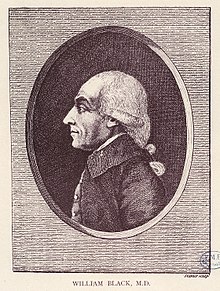William Black (medic)
William Black (* 1749 in Ireland ; † 1829 ) was an English doctor , pharmacologist , medical historian and the first well-known medical statistician .
life and work
He studied and obtained his doctorate in Leyden in 1771 , the title of his thesis Dissertatio medica de Pathologica inauguralis diagnosi, prognosi, et causis mortis in febribus , loosely translated "Diagnosis, prognosis and cause of death in fever". He owes the renunciation of superstition and the decline of "disgusting and meaningless" medicines like "powdered skulls" and "a mishmash of other filth" at least in literature. In 1924 Mumia vera Aegyptica was offered as a drug by the Darmstadt company Merck at a price of 12 gold marks per kilo.
In 1785 he settled in London and was together with Gilbert Blane (1749-1834) doctor at the General Dispensary for Poor Married Women. Black can be cited as one of the founders of evidence-based medicine . This can be traced back to the concept of medical arithmetic developed by British doctors in the 18th century . The name can be found for the first time in the article An Attempt to Improve the Evidence of Medicine by the Scottish doctor George Fordyce, published in 1793 . (see also the publication)
In addition to the "rules of medical art", the recognition of medical authority and common medical procedures, systematic observations and the empirically developed evidence of scientific studies gained in importance. However, the behavior of doctors did not change for many years, as one of the founders of the "arithmetic observation", William Black, had already foreseen in 1789:
"With respect to medical arithmetic, what time must yet revolve before ignorance and bigotry shall be enlightened, prejudices and inveterate habits done away with, envy, malevolence and calumny, I cannot determine."
The early European history of evidence-based medicine began around 1780 in Great Britain with the development of the method of arithmetic observation and around 50 years later in France with the méthode numérique . This method is to be understood as the implementation of systematic observations of patient or population groups and the use of mathematical procedures as well as the use of simple statistical methods. With this, a fundamental change in perspective for the doctor took place at this time: From the sole consideration of the individual medical history of a patient to the consideration of statistical probabilities and quantitatively reliable results. In addition, the disputes about the type of medical evidence acquisition and the training of young scientists intensified.
Works (selection)
- William Black's, the Arzneywiss. Drs. Zu London, draft of a history of medicine science and the art of medicine. Translated from English, edited and with some additions by Dr. Joh. Chr. Fr. Scherf, Hochgräfl. Lippe Hofmedicus. Meyer, Lemgo 1789.
- William Black: A comparative view of the mortality of the human species at all ages; and of the diseases and casualties by which they are destroyed or annoyed. Dilly, London 1788.
- William Black: Comparing the mortality of the human sex in all ages, their diseases and calamities. From the English. Leipzig Junius 1789.
literature
- Max Neuburger, Francis Clifton and William Black Eighteenth Century Critical Historians of Medicine. In: Journal Hist Med Allied Sci. V, pp. 44-49.
- Ulrich Tröhler: Quantifying Experience and Beating Biases: A New Cultur in Eighteens Century British Clinical Medcine. In: Gérard Jorland, George Weisz, Annick Opinel, Fondation Marcel Mérieux: Body counts: medical quantification in historical and sociological perspective. McGill-Queen's Press-MQUP, 2005, ISBN 0-7735-2925-X , pp. 19-50. (P. 35 f.)
Web links
Further evidence
- ^ Richard Sugg: 'Good Physic but Bad Food': Early Modern Attitudes to Medicinal Cannibalism and its Suppliers. In: Soc Hist Med. 19 (2006), pp. 225-240.
- ↑ Beatrix Geßler-Löhr: Mumia vera aegyptiaca in the Occident. hu-berlin.de (PDF; 9 kB)
- ↑ EbM, from English evidence-based medicine “ medicine based on evidence”, a direction in medicine that demands that patient-oriented decisions be made expressly on the basis of empirically proven effectiveness in every medical treatment .
- ^ William Black: Arithmetic and Medical Analysis of the Diseases and Mortality of the Human Species . London 1789
- ↑ quoted in U. Tröhler: To Improve the Evidence of Medicine. The 18th Century British Origins of a Critical Approach . Royal College of Physicians of Edinburgh, Edinburgh.
- ^ William Clark, Jan Golinski, Simon Schaffer: The sciences in enlightened Europe. University of Chicago Press, 1999, ISBN 0-226-10940-2 .
| personal data | |
|---|---|
| SURNAME | Black, William |
| BRIEF DESCRIPTION | English doctor, pharmacologist, medical historian and medical statistician |
| DATE OF BIRTH | 1749 |
| PLACE OF BIRTH | Ireland |
| DATE OF DEATH | 1829 |
